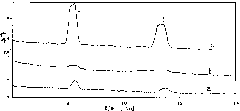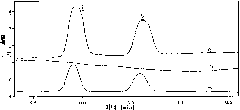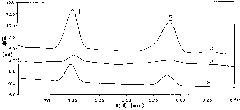Method for trapping organic compound in aqueous solution
A technology of organic compounds and aqueous solutions, applied in the fields of magnetic field/electric field water/sewage treatment, etc., can solve the problems of time-consuming, flammable solvent, toxicity, etc., to avoid low cost, avoid flammable and toxic organic solvents, and easy to operate. Effect
- Summary
- Abstract
- Description
- Claims
- Application Information
AI Technical Summary
Problems solved by technology
Method used
Image
Examples
Embodiment 1
[0033] Embodiment one: the NaCl of 1mol / L is used as leading electrolytic solution, the sodium gluconate (GANa) of 500mmol / L is as the sodium dodecyl sulfate (SDS) solution of tailing electrolytic solution, 100mmol / L and contains two kinds of organic aromatic The aqueous solutions of 1 mg / L of ketone compounds (phenylpentanone and phenylhexanone) are put into the electrolytic cell made of glass, and the arrangement order of each solution in the electrolytic cell is as follows (the two solutions connected by short lines are in contact with each other):
[0034] NaCl (1mol / L)-aromatic ketone aqueous solution (each 1mg / L)-SDS (100mmol / L)-GANa (500mmol / L) The anode of the DC power supply of the electrolytic cell is in contact with the NaCl solution and the cathode is in contact with the GANa solution. Apply 300V DC voltage to drive the SDS aggregate until almost all the aromatic ketone aqueous solution passes through, and quickly take out the part of the solution rich in SDS aggreg...
Embodiment 2
[0036] Embodiment two: the NaCl of 1mol / L is used as the leading electrolyte solution, the β-alanine of 500mmol / L as the trailing electrolyte solution, the cetyltrimethylammonium chloride (CTAC) solution of 100mmol / L and containing two Each 1mg / L aqueous solution of a kind of naphthyl alcohol compound (naphthalene methanol and naphthyl alcohol) is put into the electrolytic cell of glass material, and the order of arrangement of each solution in the electrolytic cell is as follows (two kinds of solutions connected by short lines are in contact with each other):
[0037] The anode of NaCl (1mol / L)-naphthyl alcohol aqueous solution (each 1mg / L)-CTAC (100mmol / L)-β-alanine (500mmol / L) electrolytic cell DC power supply contacts with β-alanine solution and the negative electrode Contact with NaCl solution. Apply a DC voltage of 300V to drive the CTAC aggregates until almost all the naphthyl alcohol aqueous solution passes through, and quickly take out the solution part rich in CTAC a...
Embodiment 3
[0039] Embodiment three: the sodium dodecylbenzene sulfonate (SDBS) solution that uses the NaCl of 1mol / L as leading electrolytic solution, the sodium gluconate (GANa) of 500mmol / L as trailing electrolytic solution, 100mmol / L and contains two kinds Aqueous solutions of 1 mg / L each of aromatic ketone compounds (phenylpentanone and phenylhexanone) were put into a glass electrolytic cell, and the order of arrangement of each solution in the electrolytic cell was as follows (the two solutions connected by short lines contact each other):
[0040] NaCl (1mol / L)-aromatic ketone aqueous solution (each 1mg / L)-SDBS (100mmol / L)-GANa (500mmol / L) The cathode of the DC power supply of the electrolytic cell is in contact with the GANa solution and the anode is in contact with the NaCl solution. Apply 300V DC voltage to drive the SDBS aggregate until almost all the aromatic ketone aqueous solution passes through, and quickly take out the solution part rich in SDBS aggregate. Turn off the pow...
PUM
 Login to View More
Login to View More Abstract
Description
Claims
Application Information
 Login to View More
Login to View More - R&D
- Intellectual Property
- Life Sciences
- Materials
- Tech Scout
- Unparalleled Data Quality
- Higher Quality Content
- 60% Fewer Hallucinations
Browse by: Latest US Patents, China's latest patents, Technical Efficacy Thesaurus, Application Domain, Technology Topic, Popular Technical Reports.
© 2025 PatSnap. All rights reserved.Legal|Privacy policy|Modern Slavery Act Transparency Statement|Sitemap|About US| Contact US: help@patsnap.com



